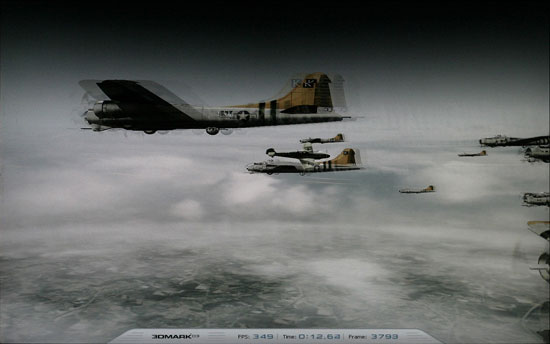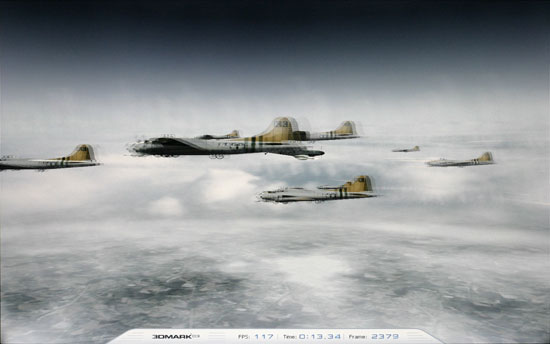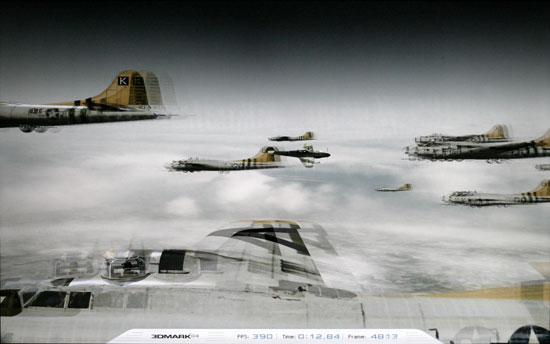Laptop LCD Roundup: Road Warriors Deserve Better
by Jarred Walton on May 22, 2007 5:00 AM EST- Posted in
- Displays
Response Times
Another topic that almost always comes up with LCDs is their response times, especially when compared to CRTs. Of course, on notebook computers technologies like CRTs are not a viable option - not unless you want to haul around one of those old 40 pound Compaq boxes with a 4" display that hides behind the fold down keyboard? (Ed: ah, those were good times!) While even the best desktop LCDs still exhibit some slight pixel smearing, the vast majority of users are okay with the level of performance now available. Considering that laptops now seem to be lagging behind desktops by a couple years in terms of quality and features, though, how do the laptop LCDs fare?
Since we were unable to send the same image simultaneously to multiple laptop displays, we resorted to simply taking pictures of a familiar scene from 3DMark03. We used the first game test in part because it has higher contrast images that make the frame transitions more visible, but also because at least one of the laptops struggled to get above 60 frames per second even at seriously reduced resolution and quality settings. (We ran the MSI at 640x400 rather than the native 1280x800 because the IGP would otherwise average in the low teens on frame rates, resulting in overlapping frames. The other laptops were run at their native resolutions and experienced no difficulties with this rather old benchmark.) We took numerous pictures on each laptop, and then selected one that seemed to best represent the performance. Here are the images we captured:
We couldn't find any manufacturer specifications suggesting what sort of response times we should be experiencing with any of these laptops, but judging by the above images we would venture to say that a rating of 25ms or lower would be appropriate. You can clearly see at least three frames on every one of the laptops, sometimes more. The A8Js and XPS M1710 both show four frames, although at least one of the frames is barely visible on each laptop. Since we also have to account for shutter lag on the camera, we would say that these two laptops appear to take around two frame updates resulting in an approximate response time of 33ms. The G2P and S271 on the other hand appear to take somewhere between one and two frame updates, giving them a response time of between 16ms and 33ms.
Considering that some of these notebooks really won't be used for gaming anyway (particularly the MSI S271), response time is not necessarily a critical factor. However, we certainly wish an "extreme gaming" laptop like the Dell XPS M1710 could provide better response times, and more importantly better overall display quality.
Another topic that almost always comes up with LCDs is their response times, especially when compared to CRTs. Of course, on notebook computers technologies like CRTs are not a viable option - not unless you want to haul around one of those old 40 pound Compaq boxes with a 4" display that hides behind the fold down keyboard? (Ed: ah, those were good times!) While even the best desktop LCDs still exhibit some slight pixel smearing, the vast majority of users are okay with the level of performance now available. Considering that laptops now seem to be lagging behind desktops by a couple years in terms of quality and features, though, how do the laptop LCDs fare?
Since we were unable to send the same image simultaneously to multiple laptop displays, we resorted to simply taking pictures of a familiar scene from 3DMark03. We used the first game test in part because it has higher contrast images that make the frame transitions more visible, but also because at least one of the laptops struggled to get above 60 frames per second even at seriously reduced resolution and quality settings. (We ran the MSI at 640x400 rather than the native 1280x800 because the IGP would otherwise average in the low teens on frame rates, resulting in overlapping frames. The other laptops were run at their native resolutions and experienced no difficulties with this rather old benchmark.) We took numerous pictures on each laptop, and then selected one that seemed to best represent the performance. Here are the images we captured:
 ASUS A8Js  ASUS G2P  Dell XPS M1710  MSI S271 |
| Click to enlarge |
We couldn't find any manufacturer specifications suggesting what sort of response times we should be experiencing with any of these laptops, but judging by the above images we would venture to say that a rating of 25ms or lower would be appropriate. You can clearly see at least three frames on every one of the laptops, sometimes more. The A8Js and XPS M1710 both show four frames, although at least one of the frames is barely visible on each laptop. Since we also have to account for shutter lag on the camera, we would say that these two laptops appear to take around two frame updates resulting in an approximate response time of 33ms. The G2P and S271 on the other hand appear to take somewhere between one and two frame updates, giving them a response time of between 16ms and 33ms.
Considering that some of these notebooks really won't be used for gaming anyway (particularly the MSI S271), response time is not necessarily a critical factor. However, we certainly wish an "extreme gaming" laptop like the Dell XPS M1710 could provide better response times, and more importantly better overall display quality.










55 Comments
View All Comments
koljit singh - Saturday, August 9, 2008 - link
hii was confused in different manufacturers making same size lcds and which one fit which ones ?
i would like to import them but the model no are so huge it seems difficult to import all of them
is there any way to find out which ones fit which ones like compatibility chart would be great help
thanks
koljit
Oscarine - Wednesday, May 23, 2007 - link
Just a point of note that probably holds true for all the laptop manufacturers (especially Dell). Although the basic technology process for the displays I'm sure is the same, the quality of the sourced display even in the same model can vary wildly. When purchasing a dell with a WUXGA+ Res screen you could be recieving any number of manufacturers displays, fro Phillips, LG, Samsung, etc, and even among those manufacturers numerous different versions of the same panel. Case in point I owned a Dell 9300, with a samsung wuxga+ screen, it had poor contrast, miserable colors, and horrible light bleeding. Whereas my wife's 9300 had LG unit that had much better contrast, richer but less accurate color, and much less light bleed. All of this within the same model, at the same time period. So just like all the other components from DVD, HDD, even keyboards and whatnot are sourced from multiple manufacturers so are the displays, and some are significantly better than others in performance.JarredWalton - Wednesday, May 23, 2007 - link
Yeah... which really sucks but unfortunately we can't do much about it other than point out the fact. I will try to determine the panel manufacturers on the various laptops and update the table to reflect this information.lazybum131 - Tuesday, May 29, 2007 - link
Just a note about the updated table with the panel vendors, most likely the Seiko Epson panel reported for the M1710 is actually a Samsung panel. I just replaced a Samsung panel with a LG-Philips on my Latitude D620 (you may have heard about the screen complaints), where Astra reported the Samsung as a Seiko Epson SEC4457.Wesleyrpg - Wednesday, May 23, 2007 - link
hey there, great and infomative article.Any ideas who the manufacturer is of the panels in each laptop? I'm curious about the G2P, and apparently the A8JS has two different manufacturers of the panel used in it depending on the country you are based in.
I'm using a fujistu lifebook n6220, its got a Samsung 17inch panel, 1440 x 900, and a beautiful display, i wonder if its the same panel as the G2P???
austonia - Wednesday, May 23, 2007 - link
The quality of the display (viewing angles, brightness, contrast) is very high on my priority list when buying a notebook, yet few of them come with a decent display and few sites/reviewers focus on it. I hope Anandtech will follow up on this idea with a wider range of notebooks, when they can.jmvillafana - Tuesday, May 22, 2007 - link
This is a great topic with too few attention. As IT head for a large corporation I used to have Dell as standard for Laptops I used to be glad with response from the total user experience. When switching some 50 users from ispiron 8600 provided in 2004 to a Latitude D820 in late 2006, we had very bad comments. Better speed, better resolution, but the display brightness and clarity was really difficult in users eyes. When looking around for options of other brands, we found similar trends in other brands. Toshiba´s looked better than Dell´s still were not as good as their own laptops from three years before. It seems that most brands have looked for this area as a cut cutting opportunity. The problem is that we could not get better displays even as options for additional cost. The company that grabs this as a marketing opportunity has a good chance of making good money.figuerc - Tuesday, May 22, 2007 - link
Agreed - my old Toshiba (Celeron 400) has a better screen then my newer one (P4 2.8 ghz - not that new). Some of the newer dells and gateways are just terrible on the eyes.Theguynextdoor - Tuesday, May 22, 2007 - link
This little laptop has the Xbrite screen with an LED bulb. Does anyone know if this will be tested anytime soon?JarredWalton - Tuesday, May 22, 2007 - link
If Sony deems to send us one, we will happily test it. We don't have any contacts at Sony right now, unfortunately, so the best we can do is ask and hope for a response. If any of you have an inside track at Sony, tell them to contact me via email.